The Meizu MX4 Pro Review
by Andrei Frumusanu on February 16, 2015 2:00 AM EST- Posted in
- Smartphones
- Exynos
- Mobile
- Meizu
CPU Performance
I've talked a bit about the Exynos 5430 in my Note 4 Exynos review where I revealed some benchmark numbers from the Galaxy Alpha. The 5430 is a 4xA7, 4xA15 octa-core SoC that is running big.LITTLE in heterogeneous multi-processing mode on top of a GTS ("Global Task Scheduling") software implementation.
In the Meizu MX4 Pro we see the A7 cores clocked at a higher 1.5GHz, with the A15 running at up to 2.0GHz. I noticed that the CPU isn't allowed to scale above 1.8GHz unless certain boost mechanisms are activated, such as switching apps. Since Meizu hasn't divulged the source code for the MX4 Pro, I can't be too sure how this mechanism works. The effect is that most benchmarks should actually have the CPU running at a 1.8GHz limit instead of 2.0GHz. Memory is limited to LPDDR3-1650 speeds, providing a theoretical 13.2GB/s bandwidth to the SoC.
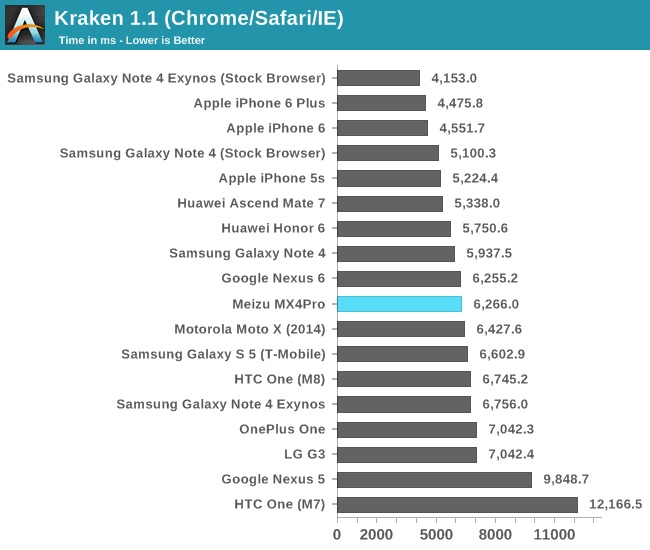
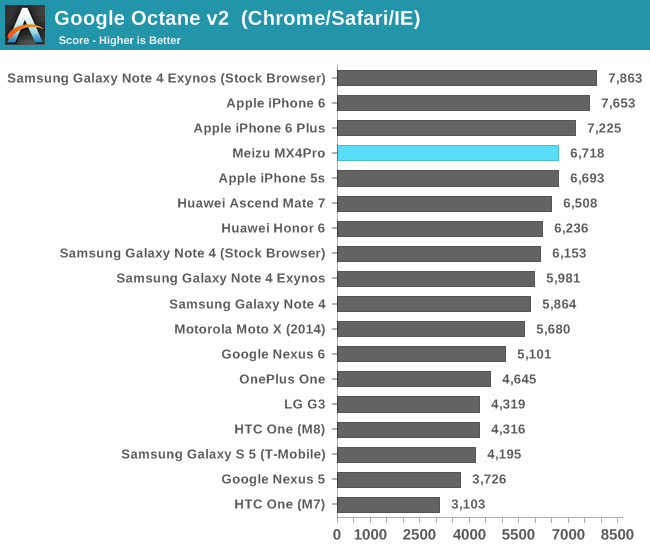
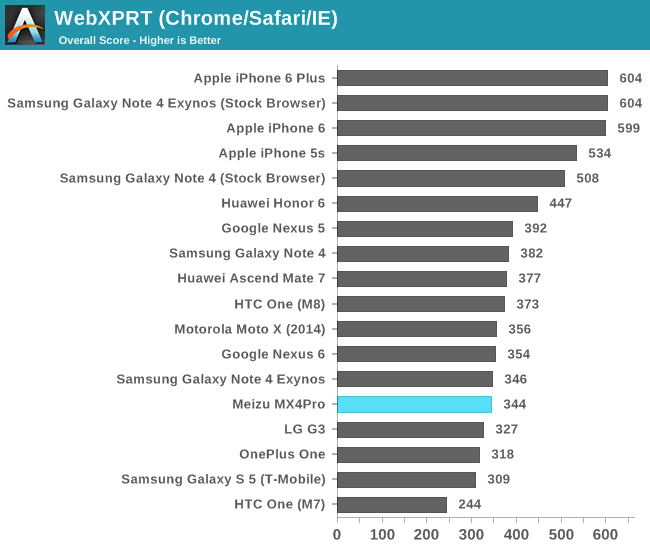
We've dropped SunSpider from our 2015 test suite as it was too sensitive as a micro-benchmark to browser optimizations and JavaScript engine compiler targets. Turning back to Kraken we see that the MX4 Pro doesn't perform that well, ending up in the middle of our latest flagship devices. The Alpha was able to achieve 4973ms on the same SoC, pointing to worse software optimization. Octane, being created by Google, achieves better scores in Chrome.
I've mentioned in the software section that the stock browser underperforms Chrome in the benchmarks. It's a pity because we've seen from the Exynos Note 4 review just how much performance can be squeezed out of the stock browser if properly optimized for the SoC-specific hardware. The 5430 should perform much better in native benchmarks.
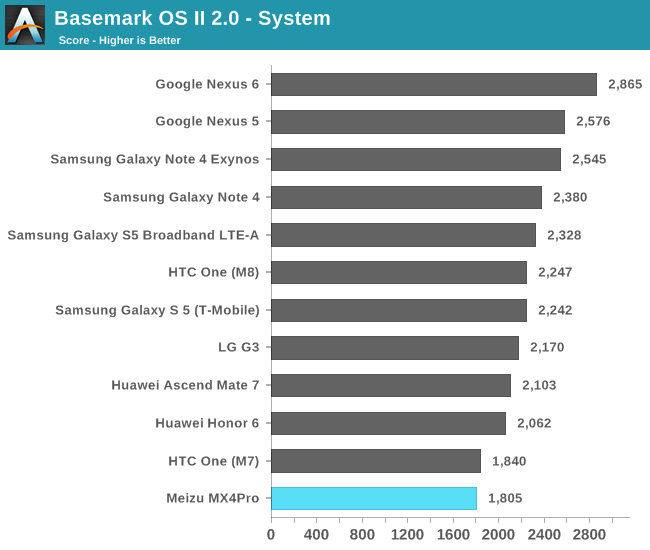
Starting with BaseMark OS II's system test, we see that the MX4 Pro scores quite low. The Galaxy Alpha with the same SoC scores 1958 points, about 10% higher. With both Lollipop Nexus devices topping this benchmark, it's clear that software optimizations bring lots of advantage to a device's ranking in this test.
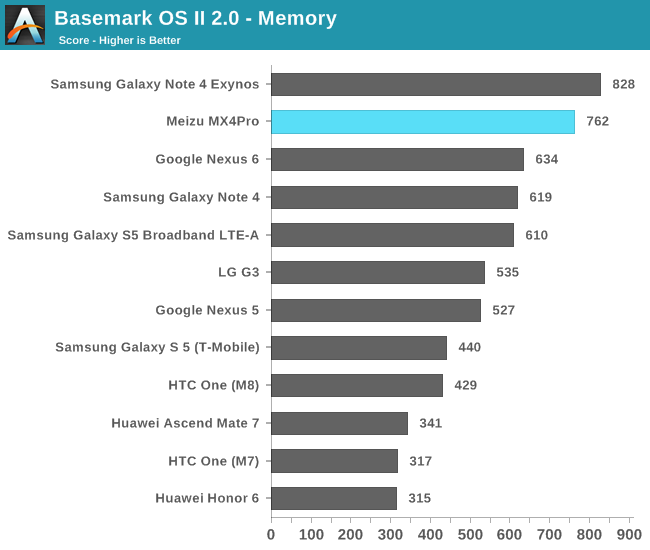
The Meizu performs excellently in the memory test, where the NAND is stressed and throughput is tested in collection of memory benchmarks. Although the Meizu does not possess the second-best eMMC module of the benchmarked phones, it looks again that Samsung's controller for some reason outperforms the competition by a sizeable margin.
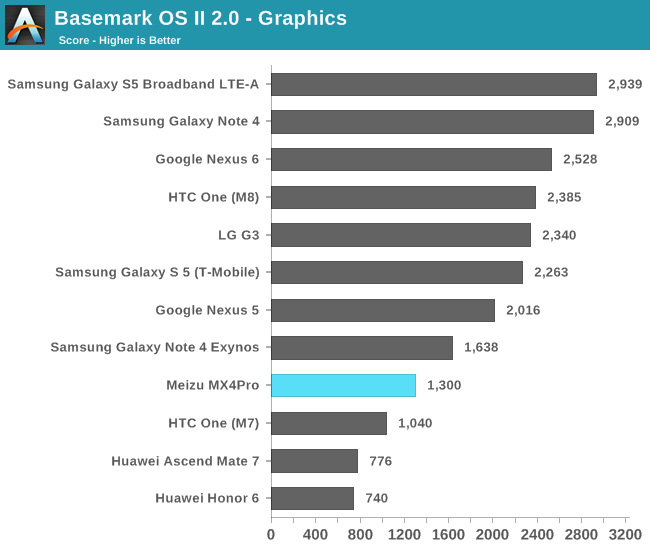
The Mali T628MP6 doesn't manage to keep up with the Qualcomm GPUs. We're again seeing it perform badly, consistent with the other Mali devices in this listing.
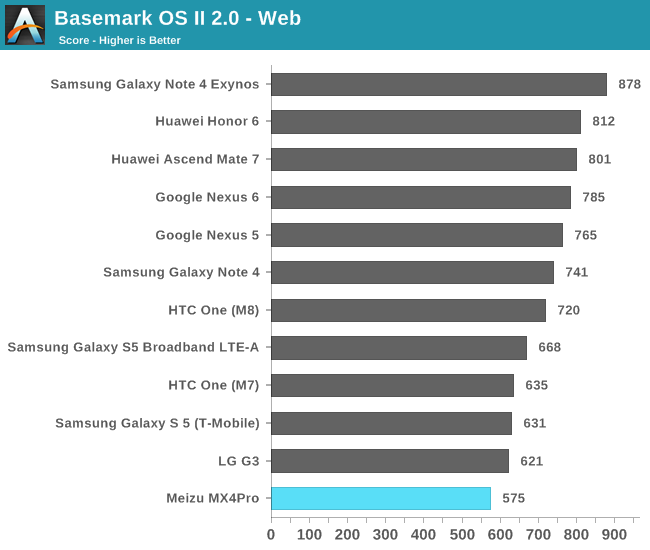
Lastly, the web test also puts the MX4 Pro last among the current generation flagships. The Alpha managed to achieve a score of 812 in this test. I may be repeating myself here but the reason is obvious: software, software, software.
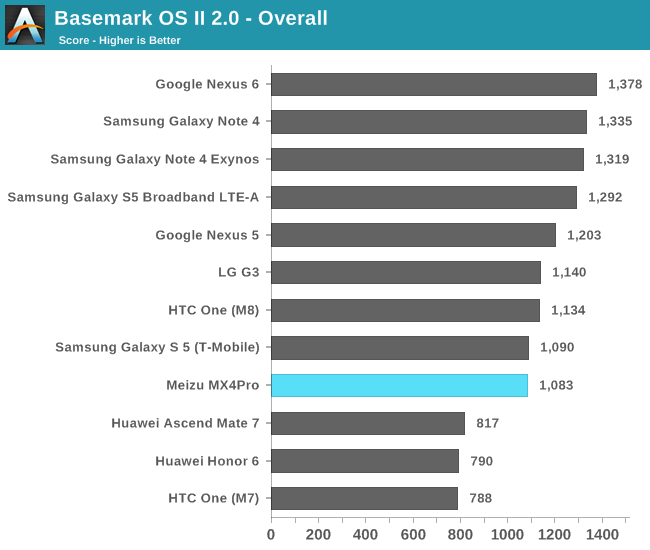
The overall BaseMark OS II score puts the MX4 Pro slightly under last generation's flagships such as the Galaxy S5, One M8, and the G3.
Moving over to PCMark, one of our newer additions to our mobile test suite, we're taking a look at real-world performance scenarios that one would encounter in daily apps and usage of a smartphone. These benchmarks are very OS sensitive and thus give a better impression of a device's real performance instead of synthetic CPU tests.

The web browsing test starts out as positive for the MX4 Pro, being able to reach the top performing group of devices on this benchmark. It's interesting to see how all ARM Cortex A15 and A57 devices are able to consistently outperform Qualcomm's Krait SoCs in this test.
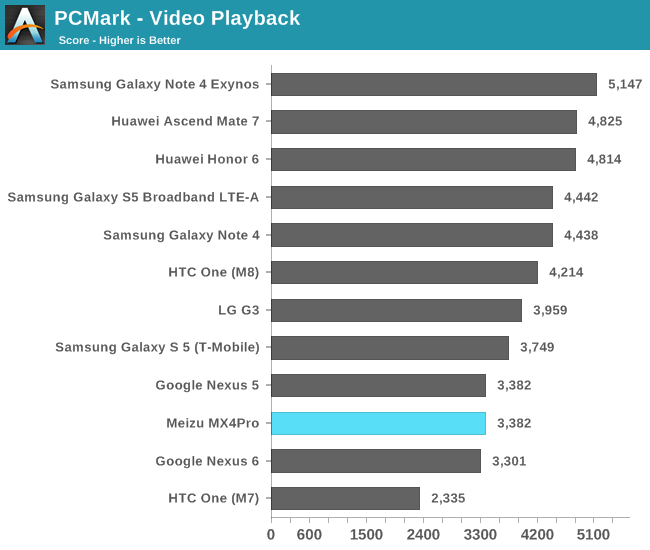
The video playback test uses the native Android MediaPlayer API to play back a 1080p H.264 baseline 4.0 video, with a variable target bit rate of 4.5Mbps at 30 FPS. What is measured here is the time needed to open the video samples, their average frame-rates, and the seek time when skipping through the videos.
The Meizu isn't performing too well in the video playback test. We saw how the Note 4 Exynos was able to outperform its Qualcomm counterpart with help of better eMMC controller performance and a good hardware decoder, but that doesn't seem to translate to the MX4 Pro in this test.
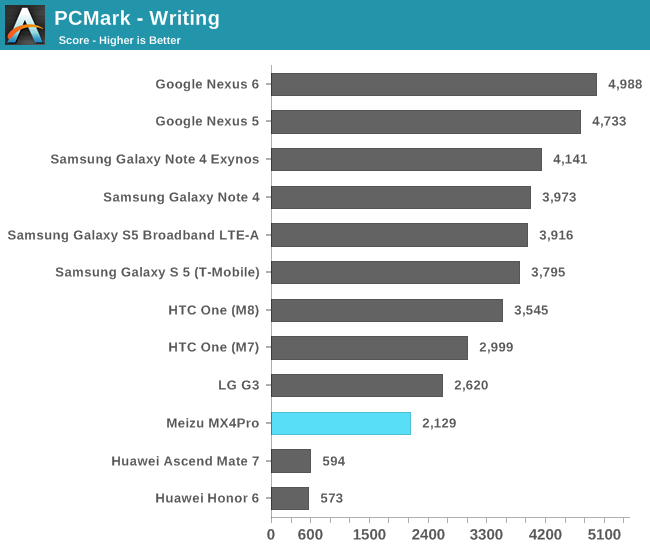
The writing test measures performance when manipulating a native EditText view. It loads, uncompresses, and pastes two documents together into what results in a 200k character piece of text. This is then compressed into a ZIP and saved. Further text manipulation is done and the API overhead and performance is measured.
It seems we're again hitting a software bottleneck here as the MX4 Pro behaves badly compared to our current flagship devices. Only Huawei's phones (which seem to be clearly broken in this benchmark) perform worse.

The photo editing test is a mix between API performance and both GPU and CPU performance. Image effects are applied via both the native effect API in Android, and also a RenderScript that tests heterogeneous processor performance (GPU and CPU). Additionally a Java library is used to test Java performance through processing filters that are computed on the CPU.
Here the MX4 Pro manages to come in last yet again. Did I mention software optimizations yet?
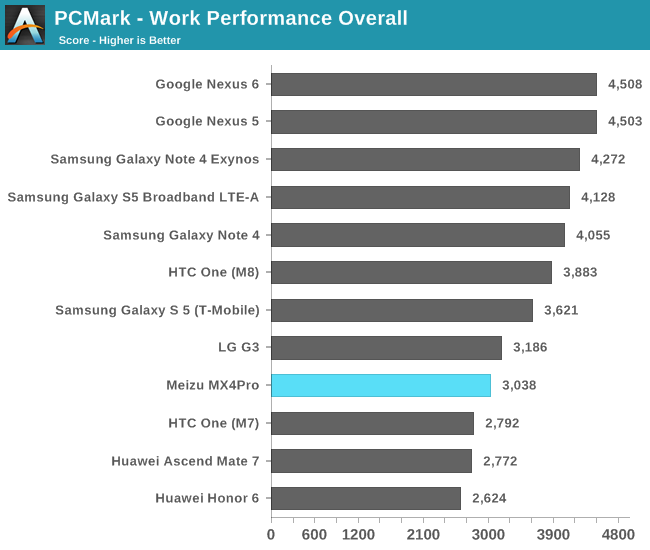
The overall work performance score puts the MX4 Pro just slightly higher than the Huawei counterparts that employ a similar SoC, and it's able to just outperform the last generation of SoC devices such as the Snapdragon 600 found in the One M7. What I've noticed while using the phone is that these numbers roughly correlate with what I've seen in real-world performance. Sometimes applications take a fraction of a second longer to open, or an app takes just a little bit longer to load a screen. I would be extremely curious how the MX4 Pro would perform on ART and Lollipop, because it's clear that there's a general lack of hardware optimizations on the stock ROM. Here's hoping that Meizu is listening and future software updates are able to improve performance.
NAND Performance
The Meizu MX4 Pro employs a SanDisk manufactured eMMC solution, the SDW32G with NAND storage manufactured by Toshiba. This should be an eMMC5.0 solution supporting HS200-DDR operation. Indeed when looking at the maximum sequential read and write scores in our AndroBench storage benchmarks, we see that the solution doesn't perform badly at all and is able to keep up with the current flagship generation, even outperforming some such as the Galaxy S5 or the One M8.
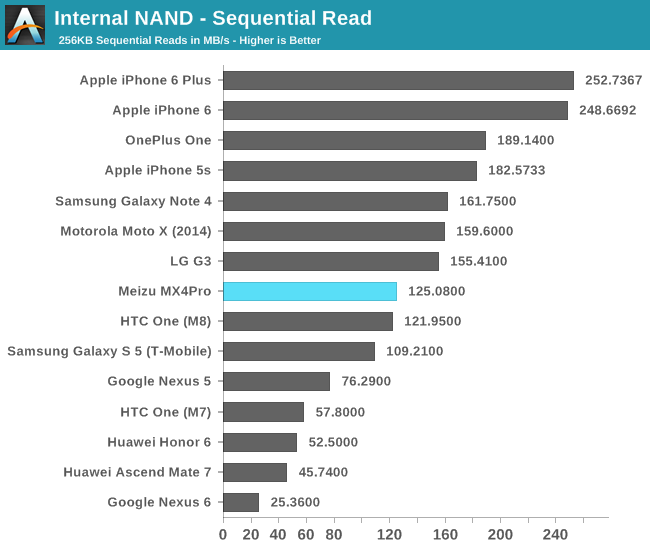
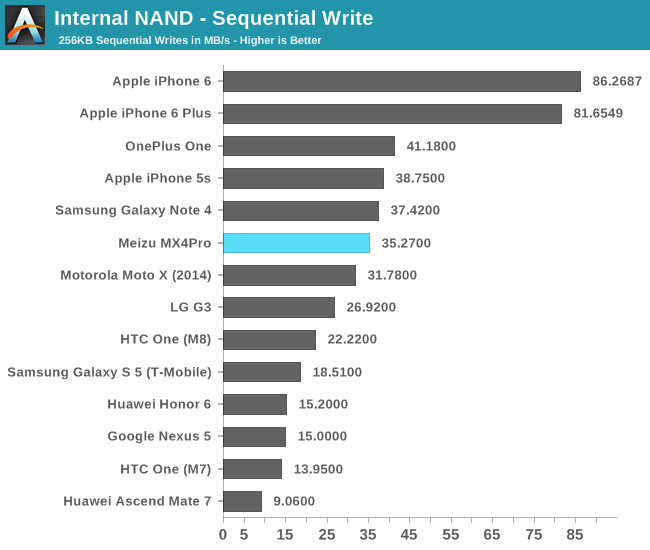
Switching over to the random read test, we see the MX4 Pro falling behind compared to the more expensive high-end competition.
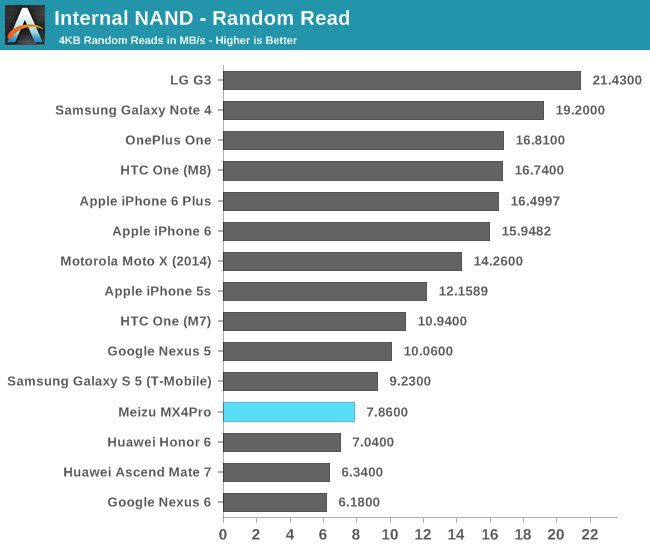
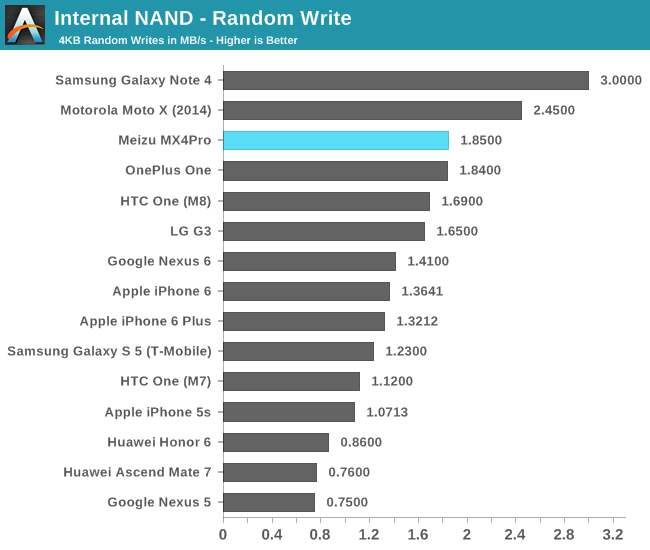
The random write test performs better for the SanDisk eMMC as it lands our 3rd best score. Overall I think Meizu employed a performant and competitive NAND solution on the MX4 Pro, a surprising conclusion given the bad experience we've had until now with Chinese phones and the poor showing of some other China-focused devices.










70 Comments
View All Comments
bigstrudel - Friday, February 20, 2015 - link
Google has cooperated with the NSA since day 1.Google Maps for instance was purchased from the US Govt intelligence community. Android is "secured" with SELinux, provided by the intelligence community.
Its all out there on the internet.
Wall-Swe - Wednesday, February 18, 2015 - link
US gov creates spyware that invades the firmware of HDDshttp://www.neowin.net/news/us-gov-creates-spyware-...
nevertell - Monday, February 16, 2015 - link
Anything with a SIM card has a backdoor because the spec for implementing SIM cards into devices requires the vendor to provide an API to the simcard with root privileges. The SIM card actually runs it's own code, it has it's own memory, and it's completely opaque. If you want to feel safe about your privacy, don't put sensitive data on your phone, or just don't use one.ScorpionRaY - Monday, February 16, 2015 - link
Every phone has a backdoor. The only important question is, do you really have valuable information worth NSA looking at?Valis - Monday, February 16, 2015 - link
Not my K750i that I still use. =) Awesome device.web2dot0 - Monday, February 16, 2015 - link
Come on, don't use your juvenile logic. Information which may seem unless to you can become very useful for the NSA to finding out your behavioural pattern, shopping patterns, who your friends are, what you say to your friends, places where you'll most likely be in the future.The information on its own is very useless, but if you map it out, it become very useful and highly private information.
ZhenWan - Monday, February 16, 2015 - link
Well, it's better having a backdoor in Chinese made programs than backdoors in US made programs, I rather prefer to have a company exploiting my interests than a Government-funded organisation specifically made to tap into everything I do, "For the safety of "National" Security". *Cough* NSA, *Cough* CIA, *Cough* GCHQ....theduckofdeath - Tuesday, February 17, 2015 - link
To be really cynical. The Chinese aren't breaking any laws spying on Americans, while Americans bends over and lets their government feck them in the arse every day, breaking any law they see fit.Hypocrite Americans......
sonny73n - Tuesday, February 17, 2015 - link
So true.Wall-Swe - Wednesday, February 18, 2015 - link
Did you miss the news yesterday, that basically every hard drive sold in recent years have exploits built in to the firmware that is impossible to remove, curtesy of the NSA in the US .So don't point your finger at China, when the US are the bad guys.